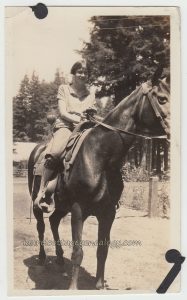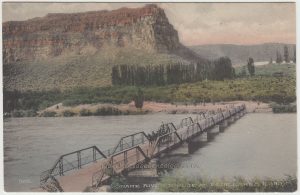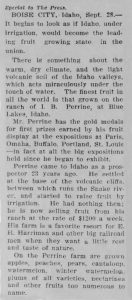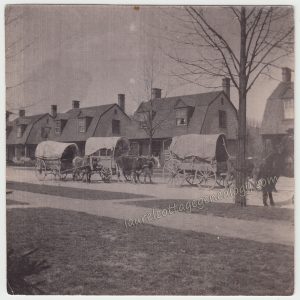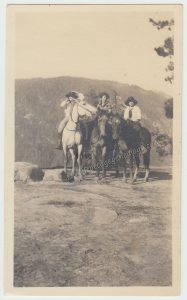
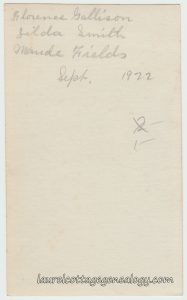
Old photo, white border. September 1922.
Price: $15.00 Size: About 2 and 1/2 4 and 1/4″
A great remembrance of a wonderful day: Three friends, identified on the back as Florence Gallison, Zilda Smith and Maude Fields, September 1922. The three cowgirls at heart are posed on horseback in front of a scenic view in, it’s a safe bet to say the Sierras, maybe in or near the Stanislaus National Forest, or Yosemite National Park. Reason being is that the three were only found in reasonable proximity, living in the Central Valley of California: Florence and Maude in Turlock and Zilda in Stockton.
Note: There were two Florence Gallison’s in the area, but Florence G. Gallison was ruled out as she was a Gallison by marriage, and was not married until after 1922.
Below, a short news blip that appeared in the Modesto Evening News, June 17, 1914, informing that Florence (she would have been about fourteen) was spending the summer in Sugar Pine, California (near the south entrance to Yosemite National Park.)

UPDATE re a banjo: Please be sure to read the comment below from Jay, who so kindly provided the color photos. As you will note from one of the photos, our three horseback adventurers were part of a musical endeavor called the Yosemite Blind Bats. As of March 28, 1923, the band members were:
F. C. Alexander; H. A. “Red” Halls; A. I. or A. L. Mill; F. M. Gallison; M. A. Stout; A. B. Leavitt; Gene DePaul or Depauli; Maude Field; Zilda Smith; “Edythe” Leavitt.
From our research, F. C. Alexander was Fred Colville Alexander, born Kentucky 1885. A. B. Leavitt was Amy Belle Leavitt, born San Francisco, California, April 1897. Fred and Amy married in September 1923. They were both residents of Yosemite at the time. From Fred’s WWI Draft Registration Card in 1918, his occupation was property clerk and storekeeper at Yosemite National Park, and interestingly from a musical standpoint, deaf in his right ear. By at least 1926 he was postmaster at Yosemite. (Scroll to the bottom of the page for a clip from the Santa Cruz Evening News.)
“Edythe” Leavitt was Amy Belle’s sister. Spelled Edith in records, we love the hinting toward some type of running joke re the quotation marks. She was born in California, about 1901.
And, rather grainy, but still a nice find – a photo of Zilda Smith that appeared in the Stockton Evening and Sunday Record, July 1924:
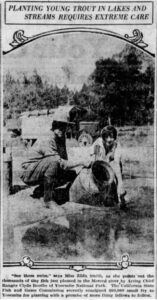
Other readable names from the banjo photos are: Pete Van Bake; Thelma Britton; Philip Patterson; [?] Van Wormer; Bob Davison; B. B. Harlett; E. M.[?] Metcalf; G. E. Comstock; [?] Thompson; The Brockway Splashes. (Brockway is an unincorporated community on the north shore of Lake Tahoe, at the California-Nevada border.)
Photos from Jay:






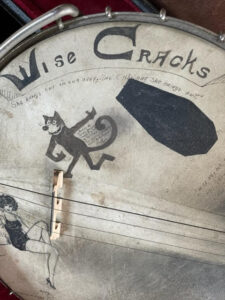
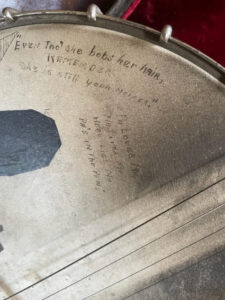
Below, Postmaster, Fred Alexander of Yosemite is involved in the arrest/custody of two n’er do wells:

Sources: Florence Gallison. Year: 1920; Census Place: Turlock, Stanislaus, California; Roll: T625_152; Pages: 1B; Enumeration District: 188. (Ancestry.com).
Maude Fields. Year: 1920; Census Place: Turlock, Stanislaus, California; Roll: T625_152; Page: 2B; Enumeration District: 184. (Ancestry.com).
Zilda Smith. R. L. Polk and Co.’s Stockton City and San Joaquin County Directory, 1925. Vol. 18, p. 59. Ancestry.com. U.S. City Directories, 1822-1995.
Modesto Evening News, June 17, 1914. Wednesday, p. 7. (Newspapers.com)
Ancestry.com. California, U.S., Marriage Records from Select Counties, 1850-1941.
Year: 1910; Census Place: Stockton Ward 4, San Joaquin, California; Roll: T624_103; Page: 1a; Enumeration District: 0144; FHL microfilm: 1374116. (Ancestry.com).
“Planting Young Trout in Lakes and Streams Requires Extreme Care.” Stockton Evening and Sunday Record, July 26, 1924. Saturday, p. 29. (Newspapers.com)
“Former Postmaster of Arkansas Town Arrested With Female Companion.” Santa Cruz Evening News, June 25, 1926. Friday, p. 1. (Newspapers.com)

